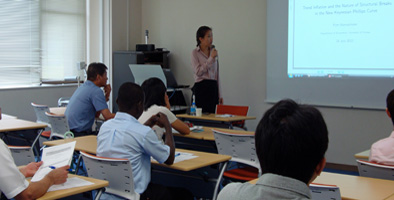Jul 19, 2012
Dr. Psy Manopimoke in her introduction explained that policy makers are very much concerned with inflation figures because they are an important tool in decision making in an economy. Therefore, it is very important to identify the driving force of inflation to make forecasts.
She explains inflation with the model; πt = (1-ɑ)Et πt+1 + kxt + ɑ πt-1, with 0 ≤ ɑ ≤ 1. Where inflation (πt) depends on expected future inflation (Et) and current output gap (xt), k is a constant term and is always positive. The forward and backward components (t+1 , t-1) help the Central Bank to reduce inflation without depressing economic activities. NKPC is used by the Central Bank to make policy decisions and for the understanding of short-run (3-5 years) inflation dynamics.
The stochastic trend component is an important and significant determinant of actual inflation dynamics. Once stochastic trend inflation is taken into account, the forward looking NKPC with regime-switching can provide a good description of postwar United States inflation data, except for the period of great inflation. Also, unlike the previous findings, the slope of the forward-looking NKPC is statistically significant.
Dr. Psy Manopimoke in conclusion explained that real economic activity still contains predictive content for inflation and Phillips curve models remain useful for forecasting inflation. Inflation has become harder to forecast since the mid 1980’s due to the disappearance of the backward-looking component in the Phillips curve in the early 1980’s.
This lecture was made possible through the invitation of APS Professor Supachit Manopimoke.
Written by Mr AMO Thompson (APU GSAM)
RCAPS Seminar: Dr. Pym MANOPIMOKE (Assistant Professor, University of Kansas)
On July 18, 2012, Dr. Pym MANOPIMOKE (Assistant Professor and Oswald Scholar, Faculty of Economics, University of Kansas) was invited to present an RCAPS Seminar entitled “Trend Inflation and the Nature of Structural Breaks in the New Keynesian Phillips Curve”.
Dr. Psy Manopimoke in her introduction explained that policy makers are very much concerned with inflation figures because they are an important tool in decision making in an economy. Therefore, it is very important to identify the driving force of inflation to make forecasts.
She explains inflation with the model; πt = (1-ɑ)Et πt+1 + kxt + ɑ πt-1, with 0 ≤ ɑ ≤ 1. Where inflation (πt) depends on expected future inflation (Et) and current output gap (xt), k is a constant term and is always positive. The forward and backward components (t+1 , t-1) help the Central Bank to reduce inflation without depressing economic activities. NKPC is used by the Central Bank to make policy decisions and for the understanding of short-run (3-5 years) inflation dynamics.
The stochastic trend component is an important and significant determinant of actual inflation dynamics. Once stochastic trend inflation is taken into account, the forward looking NKPC with regime-switching can provide a good description of postwar United States inflation data, except for the period of great inflation. Also, unlike the previous findings, the slope of the forward-looking NKPC is statistically significant.
Dr. Psy Manopimoke in conclusion explained that real economic activity still contains predictive content for inflation and Phillips curve models remain useful for forecasting inflation. Inflation has become harder to forecast since the mid 1980’s due to the disappearance of the backward-looking component in the Phillips curve in the early 1980’s.
This lecture was made possible through the invitation of APS Professor Supachit Manopimoke.
Written by Mr AMO Thompson (APU GSAM)

Video(WMV)
- TOPIC
- セミナー

